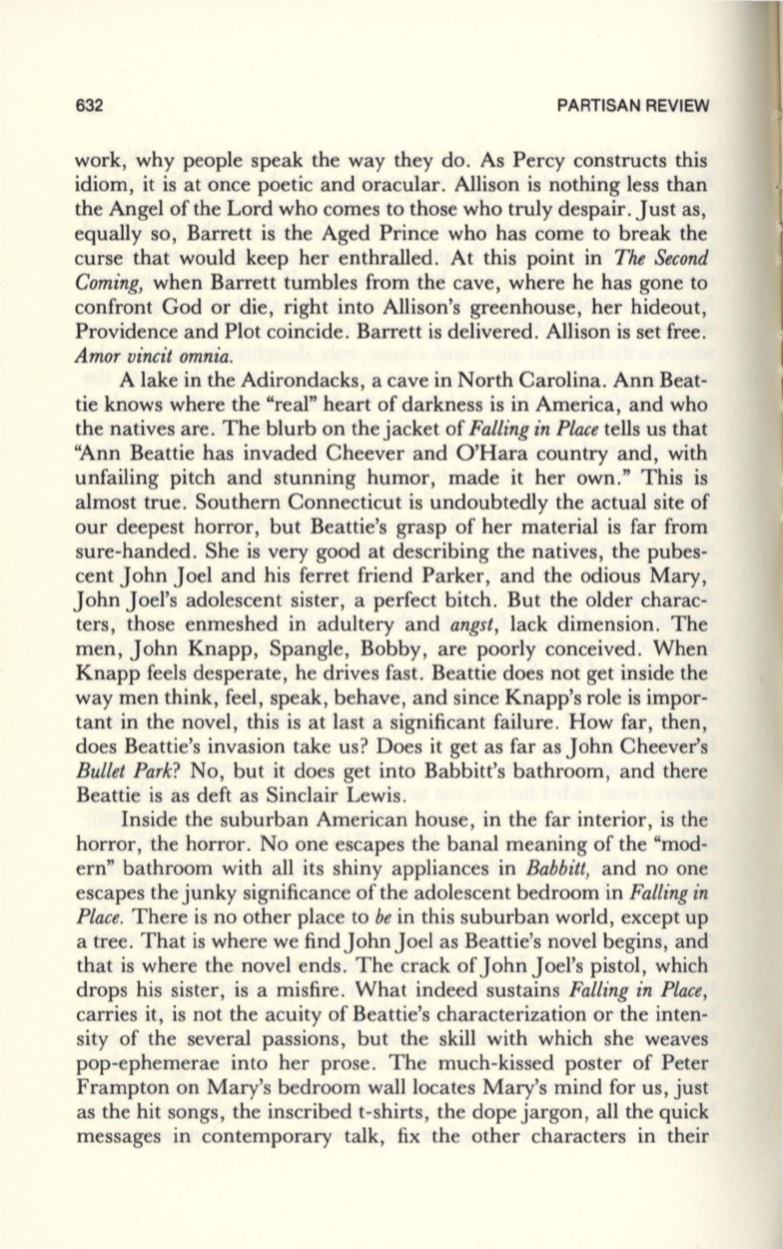
632
PARTISAN REVIEW
work, why people speak the way they do. As Percy constructs this
idiom, it is at once poetic and oracular. Allison is nothing less than
the Angel of the Lord who comes to those who truly despair. Just as,
equally so, Barrett is the Aged Prince who has come to break the
curse that would keep her enthralled. At this point in
The Second
Coming,
when Barrett tumbles from the cave, where he has gone to
confront God or die, right into Allison's greenhouse, her hideout,
Providence and Plot coincide. Barrett is delivered. Allison is set free.
Amor uincit omnia.
A lake in the Adirondacks, a cave in North Carolina. Ann Beat–
tie knows where the "real" heart of darkness is in America, and who
the natives are. The blurb on the jacket of
Falling in Place
tells us that
"Ann Beattie has invaded Cheever and O'Hara country and, with
unfailing pitch and stunning humor, made it her own." This is
almost true. Southern Connecticut is undoubtedly the actual site of
our deepest horror, but Beattie's grasp of her material is far from
sure-handed. She is very good at describing the natives, the pubes–
cent John Joel and his ferret friend Parker, and the odious Mary,
John Joel's adolescent sister, a perfect bitch. But the older charac–
ters, those enmeshed in adultery and
angst,
lack dimension. The
men, John Knapp, Spangle, Bobby, are poorly conceived . When
Knapp feels desperate, he drives fast. Beattie does not get inside the
way men think, feel, speak, behave, and since Knapp's role is impor–
tant in the novel, this is at last a significant failure. How far, then,
does Beattie's invasion take us? Does it get as far as John Cheever's
Bullet Park?
No, but it does get into Babbitt's bathroom, and there
Beattie is as deft as Sinclair Lewis.
Inside the suburban American house, in the far interior, is the
horror, the horror. Noone escapes the banal meaning of the "mod–
ern" bathroom with all its shiny appliances in
Babbitt,
and no one
escapes the junky significance of the adolescent bedroom in
Falling in
Place.
There is no other place to
be
in this suburban world, except up
a tree. That is where we find John Joel as Beattie's novel begins, and
that is where the novel ends. The crack of John Joel's pistol, which
drops his sister, is a misfire. What indeed sustains
Falling in Place,
carries it, is not the acuity of Beattie's characterization or the inten–
sity of the several passions, but the skill with which she weaves
pop-ephemerae into her prose. The much-kissed poster of Peter
Frampton on Mary's bedroom wall locates Mary's mind for us, just
as the hit songs, the inscribed t-shirts, the dope jargon, all the quick
messages in contemporary talk, fix the other characters in their


